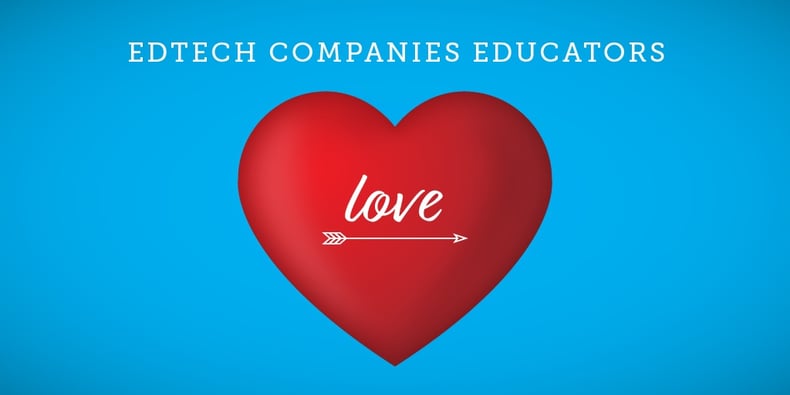
Over the past several years, K-12 education has started to shift away from delivering technology that keeps the show running behind the scenes. Instead, there has been a fresh emphasis on main stage performances—engaging learners in innovative ways to improve student outcomes.
The business models of hundreds of EdTech companies started since around 2010 have fallen into two main buckets: free for teachers (which includes both “totally free” and “freemium” models) and sales to administrators. While many of these companies are aimed at educators, other EdTech offerings primarily target consumers or parents. We thought it might be fun to highlight a few of these companies—feel free to share others in our comments section below!
Free or Not, Choices Are Not Lacking
We have all heard of Google Classroom, but countless other EdTech companies have also opted to take the “Free for Teachers” path, aggressively growing their user base by offering their products for free. Examples of such companies include Edmodo (over 60 million users), Class Dojo (over 35 million users), and Remind (over 35 million users).- Edmodo is a “social learning network” that allows teachers to share content and manage communication with students, colleagues, and parents. The company aims to empower learners by better connecting them with the people and resources that can help them realize their full potential.
- If you haven’t heard of ClassDojo (and that’s not likely!), it’s a communication app for the classroom. It connects teachers, parents, and students who use it to share photos, videos, and messages throughout the school day. Some fun facts from its website include:
- Actively used in 90% of K-8 schools in the US, and in over 180 countries
- 1 in 3 US kids aged 5–14 have learned about growth mindset and empathy with ClassDojo (see the videos here)
- Translated and used in over 35 languages
- Remind is a communication tool that helps teachers connect instantly with students and parents. It allows users to send quick, simple messages to any device. It is used in over 90% of school districts (some 60,000 schools) with 2.9 million classes connected—and to date, over 3.5 billion (yes, with a b!) messages have been sent.
- Another cool EdTech company is Duolingo. Founded in 2011, Duolingo is a leading language education platform, available through their website or via iOS and Android apps. The platform uses gamification to make the learning process fun. Users earn points for correct answers, work through set time limits, and progressively rise through different levels. What’s more, all of their language courses are free. Duolingo has reached over 100 million users globally and was awarded iPhone App of the Year in 2013.
Pay to Play
- On the not “free” side of EdTech businesses comes an amazing company called Lexia Learning, an award-winning provider of literacy assessment and instructional tools for K-12 students. Last November, THE Journal's 2016 Readers' Choice Awards were announced, and Lexia was chosen as the most valuable technology provider in K-12 classrooms. Nominated by educators across the US, Lexia earned platinum standing, surpassing all other solutions in the categories of Most Valuable Technology in Schools, Best Reading Program, and Best Adaptive/Personalized Learning Tool. Readers also selected Lexia as one of the top three technologies currently used in schools.
- Other companies offer their products with a pricing model to fit any school or district size, such as StudySync—a comprehensive, cross-curricular, core literacy program for students in grades 6–12. With hundreds of texts, dynamic video, and multimedia lessons guaranteed to inspire and advance reading, writing, critical thinking, speaking, and listening skills, StudySync aims to prepare students for college and careers. It also provides one of the most powerful digital instruction offerings with engaging print resources to ensure teachers can provide students with a systematic path to success. The program offers a diverse library of hundreds of texts—including fiction, nonfiction, classic, and contemporary—providing teachers with extensive standards-based resources. Its customizable assignments and rubrics, plus tech-enhanced assessments with ELD supports, ignites creativity, builds confidence, and advances skills. Plus, it includes social media-inspired tools and a peer-to-peer network, prompting deep analysis and inspiring students to write for an authentic audience. What's more, it can all be done anywhere, anytime, and on any device.
Startups Worth Watching
In this article, the author highlights a host of cool companies—including these three EdTech companies that are not only making a difference in NYC, but nationwide:- Newsela helps students build their reading comprehension skills by publishing daily news articles—from such sources as the Washington Post and Associated Press—across five different reading levels for grades 2–12.
- Brainscape is an app that uses adaptive flashcard algorithms to make studying more fun and effective by repeating concepts in patterns optimized to the student's learning pace. Teachers can use the software to set up classroom pages, create decks, and track learning progress. Brainscape's database also includes flashcards on everything from Shakespeare to gynecology. In the blog post, it was noted that a Columbia University study cited on the company's website found that students who study for 30 minutes using the Brainscape method see a two-fold increase in their retention abilities.
- Girls Who Code has been getting a great deal of attention recently. If you haven’t heard of them, take note: This non-profit organization introduces high school girls to computer science through instruction in coding fundamentals, web development, and design. The group offers summer immersion programs, scholarships, and after-school clubs. Interestingly, the blog post shared that the number of women who graduate with degrees in computer science is a mere 18 percent, while only 0.4 percent of high school girls express interest in majoring in the field, according to the group's website. Girls Who Code works to close the gender gap through teaching, mentoring, and engagement.
Be sure to list your favorite EdTech products—free or not—below!